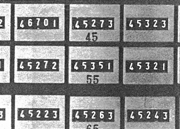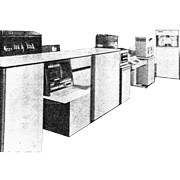Optical Character Film Reader was a high-speed and high-accuracy OCR reader equipment specialized for reading index numbers on photographic film that recorded traffic register meters. It was developed in 1973 and was introduced in the telephone charging operation since 1975.
The development of the OCR began in the 1960s. At that time, telephone billing was processed as follows. The number of telephone calls for each subscriber was counted by a traffic register meter in a telephone office(see photo of a layout of counters and their index numbers). First, the index numbers on the meter were photographed and were printed on photographic paper. Looking at the prints, then, key-punchers entered the numbers to Call Rate System. The number of telephone calls of a certain month for each subscriber was obtained by subtracting the previous month’s index number from the current month one. To eliminate billing errors, two datum entered by two key-punchers for the same index number were compared. From the mid-1960s onward, telephones became wildly popular, forcing telephone companies to develop means of entering the number of telephone calls quickly, accurately, and inexpensively instead of manual input by key-punchers. At the time the fact that there were many patients of occupational diseases such as the cervicobrachial syndrome caused a social problem, which made it hard to hire a large number of key-punchers.
Optical Character Film Reader was developed in 1972 in this context to read the index numbers recorded on film (see photo of the external view of Optical Character Film Reader). The reader moved the film mechanically and a one-dimensional array of photo sensors scanned transmitted light through the film to get the index number images. Unlike normal OCR applications, there were included many similar shape numerals such as 0, 6, 8, and 9 on the counter, and the films contained a lot of noise in the form of dust, dropouts, and blurs. To accomplish noise robust recognition, two recognition methods had been developed (weighted pattern matching method and outline feature extraction method) and successfully reduced read errors by comparing the results from the two methods. In addition, in order to distinguish number areas on the film from the counters’ cover area correctly, the reader applied two different binary threshold values. As the result of these innovations, the reader achieved acceptable accuracies to replace the previous manual hole-punching and hole-verifying operations.
Although the processing capability depended largely on the quality of the film, the reader could input data from approximately 500,000 to 700,000 subscribers, running 100 hours a month. The reader was put into full operation in 1975, and was eventually installed at all telecommunication bureaus nationwide. The readers had operated for more than 10 years until the arrival of electronic automatic exchanges and made a significant contribution to labor-saving and economizing subscriber telephone fee calculation operations.



